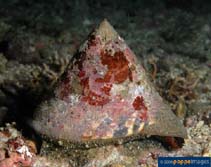Rochia nilotica (Linnaeus, 1767)
Commercial top
Classification / Names Common names | Synonyms | CoL | ITIS | WoRMS
Gastropoda | Trochida | Tegulidae | Trochinae
Environment: milieu / climate zone / depth range / distribution range Ecology
Benthic; depth range 0 - 20 m (Ref. 349). Tropical; 32°N - 25°S, 45°E - 171°E (Ref. 81851)
Distribution Countries | FAO areas | Ecosystems | Occurrences | Introductions
Indo-Pacific: from Madagascar, Sri Lanka, Andaman and Nicobar Islands, to as far east as French Polynesia, north to southern Japan and Hawaii, and south to Australia.
Length at first maturity / Size / Weight / Age
Maturity: Lm ? range ? - ? cm Max length : 15.0 cm SHH male/unsexed; (Ref. 349); common length : 11.0 cm SHL male/unsexed; (Ref. 349)
Short description Morphology
Shell conical, large, thick and very heavy. Body whorl almost smooth, with concave sides above a protuding, acutely rounded and thickened periphery. Base shell flat. Aperture squarish. Colouration: shell off-white, with large irregular axial reddish stripes (Ref. 128042).
It is the most economically important gastropod species in the tropical West Pacific. It is both an important traditional food and a leading export item used as a source of mother-of-pearl material for buttons and jewelry. Many small sized artisanal fisheries for meat and shell exist in other islands of the area. Due to severe and frequent overfishing, management policies are often adopted and aquaculture trials are under way (Ref. 349). Maximum depth from Ref. 799. Typically found in shallow, high energy portions of barrier and reefs (Refs. 349, 128042). Feeds on filamentous algae and generally avoids bottoms of sand and living corals. Population density generally decreasing in deeper areas, while the mean size of individuals increases (Ref. 349).
Life cycle and mating behavior Maturity | Reproduction | Spawning | Eggs | Fecundity | Larvae
Breeding period is marked by spring tides with external fertilization and nocturnal spawning.
Main reference
References | Coordinator | Collaborators
Poutiers, J.M. 1998. (Ref. 349)
IUCN Red List Status (Ref. 130435)
CITES status (Ref. 108899)
Not Evaluated
CMS (Ref. 116361)
Not Evaluated
Threat to humans
Harmless
Human uses
Fisheries: commercial
FAO - Fisheries: landings | FishSource | Sea Around Us
Tools
More information
Internet sources
BHL | BOLD Systems | CISTI | DiscoverLife | FAO(Fisheries: ; publication : search) | Fishipedia | GenBank (genome, nucleotide) | GloBI | Gomexsi | Google Books | Google Scholar | Google | PubMed | Tree of Life | Wikipedia (Go, Search) | Zoological Record
Estimates based on models
Preferred temperature
(Ref. 115969): 26.3 - 29.3, mean 28.7 (based on 2725 cells).
Resilience
(Ref. 69278):
Medium, minimum population doubling time 1.4 - 4.4 years (K=0.19-0.36).
Price category
(Ref. 80766):
Unknown.
Nutrients: Calcium = 126 [75, 177] mg/100g; Iron = 4.79 [1.67, 7.92] mg/100g; Protein = 15.9 [14.8, 16.9] %; Omega3 = 0.331 [0.263, 0.400] g/100g; Selenium = 57.8 [48.5, 67.2] μg/100g; VitaminA = 0 μg/100g; Zinc = 1.97 [0.92, 3.02] mg/100g (wet weight).



